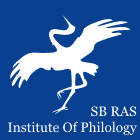 |
|
||||||||||||
|
Institute of Philology of
the Siberian Branch of Russian Academy of Sciences |
|
||||||||||||
|
|||||||||||||
| Sibirskii Filologicheskii Zhurnal (Siberian Journal of Philology) | |
|
Article
Authors: E. V. Generalova Saint Petersburg University, Saint Petersburg, Russian Federation In the section Linguistics
Abstract: The paper deals with the fixed word combinations connected with the conceptual opposition “straight – curved” in semantic aspect (the fixed word combinations include the words used in Russian with semantic meaning of “straight” or “curved”), etymological aspect (the fixed word combinations originating from the concepts of “straight” or “curved”), and onomasiological aspect (the semantics of fixed word combinations is the designation of straightness or curvature properties). The research analyses the data of historical dictionaries, card files, and dialect and phraseological dictionaries. The collocations including the lexemes with the semantics of “straight” or “curved” in a direct sense are mainly compound names, nomenclature designations of objects. In the history of Russian language, the word combinations, the phraseologization of which is based on a figurative meaning of lexemes of “straightness and curvature,” realize primarily the metaphoric models “straight / curved – truth / lie,” “straight / curved – God / devil,” “straight / curved – order, norm / disorder, deviation from the norm.” In a number of phraseo- logical units, the figurative sense is based on the metaphorical understanding of the phrase as a whole. The fixed word combinations denoting the physical characteristics of “straight- ness / curvature” are formed based on the description of a specific form or comparison with an object having such a shape. The analysis shows that the straightness was perceived as an abstract, direct, homogeneous (having a small number of concrete manifestations), positively marked quality based on the image of a direct way in the ancient time, interpreted in connection with truth, honesty, God and divine. And the curvature was perceived as a concrete, mediated, polytypic negatively estimated quality, interpreted in connection with the lie, devil, evil, and also hard work. Keywords: Russian language, historical lexicology, phraseology, fixed word combination, mental opposition, cultural semantics Bibliography: Kolesov V. V. Semanticheskiy sinkretizm kak kategoriya yazyka [Semantic syncretism as a category of language]. Vestn. Leningr. gos. univ. Ser. 2. Istoriya. Yazykoznaniye. Literaturo- vedeniye. Leningrad, no. 2, pp. 40–49. Leeuwen-Turnovcova I. Krumm und Drehen im Kulturparadigma der Ordnung. Znakolog. 1991, no. 3, pp. 131–166. Leeuwen-Turnovcova I. Rechts und Links in Europa. Berlin, 1990, 280 p. Leeuwen-Turnovcova I. Warum ist das Recht gerade? Zeitshrift fur slavische Philologie. 1992, no. 51, pp. 52–73. Lisitsyna T. A. Prostranstvennyye obrazy zhiznennogo mira v yazyke nauki i iskusstva XVIII veka [Spatial images of the vital world in the language of science and art of the 18th century]. In: Istoricheskiy istochnik: chelovek i prostranstvo: Tez. dokl. i soobshcheniy nauch. konf., Moskva, 3–5 fevralya 1997 g. [Historical source: man and space: Proc. report and messages of scientific. conf., Moscow, Febr. 3–5, 1997, Moscow]. Moscow, 1997, pp. 132–135. Mikhaylovskaya N. G. O tematicheskom upotreblenii nekotorykh sinonimichnykh prilaga- tel’nykh v yazyke drevnerusskikh pamyatnikov XI–XVII vekov [On the thematic use of some synonymous adjectives in the language of ancient Russian monuments of the 11–17th centuries] In: Russkaya istoricheskaya lesikologiya: Sb. st. [Russian historical foresticology: Coll. of art.]. S. G. Barkhudarov (Ed.). Moscow, Nauka, 1968, pp. 96–103. Mokiyenko V. M. Ot avosya do yatya. Pochemu tak govoryat?: Sprav. po russkoy idiomatike [From Avos to Yat. Why do they say so?: Handbook of Russian idiomatics]. St. Petersburg, SPbU Publ., 1998, 512 p. Sokolovskaya L. V. Istoriya slov s kornem -luk-/-lyak- v russkom yazyke ХI–ХX vv. (seman- ticheskiy aspekt) [History of words with the root luk-/-lyak- in Russian of 11–20th centuries (semantic aspect)]. Abstract of Cand. philol. sci. diss. Perm, PSU, 1996, 16 p. Suprun A. E. Vvedenie v slavyanskuyu filologiyu [Introduction to Slavic Philology]. Minsk, Vysh. shk., 1989, 432 p. Tolstaya S. M. Kul’turnaya semantika slavyanskogo *kriv- [Cultural semantics of Slavic *kriv-]. In: Slovo i kul’tura: Pamyati N. I. Tolstogo [Word and culture: in memory of N. I. Tolstoy]. T. A. Agapkina, A. F. Zhuravlev, S. M. Tolstaya (Eds.). Moscow, Indrik, 1998, vol. 2, pp. 215–230. Tseytlin R. M. Kornevye leksiko-semanticheskie gruppy so znacheniyami pryamizny – krivizny v drevnikh slavyanskikh yazykakh [Root Lexico-Semantic Groups with Straight Values – Curvatures in the Ancient Slavic Languages]. Paleobulgarica. 1990, no. 1, pp. 91–105. Tseytlin R. M. Sravnitel’naya leksikologiya slavyanskikh yazykov Х/ХI–ХIV/ХV vv. [Comparative Lexicology of Slavic languages of 10/11–14/15th centuries]. Moscow, Nauka, 1996, 232 p. Yagunova E. V., Pivovarova L. M. Ot kollokatsiy k konstruktsiyam [From collocations to structures]. In: Pusskiy yazyk: konstruktsionnyye i leksiko-semanticheskiye podkhody [Russian language: constructional and lexico-semantic approaches]. S. S. Say (Ed.). St. Petersburg, 2011. (Acta linguistica Petropolitana; Tr. ILI RAN. N. N. Kazanskiy (Ed.)). Zelenin D. K. Tabu slov u narodov vostochnoy Evropy i severnoy Azii [Tabu of words among the peoples of Eastern Europe and North Asia]. In: Sbornik Muzeya antropologii i etnografii [Collection of Museum of Anthropology and Ethnography]. Leningrad, AN SSSR, 1930, vol. 9, iss. 2, pp. 3–166. |
 |
Institute of Philology Nikolaeva st., 8, Novosibirsk, 630090, Russian Federation +7-383-330-15-18, ifl@philology.nsc.ru |
© Institute of Philology |


